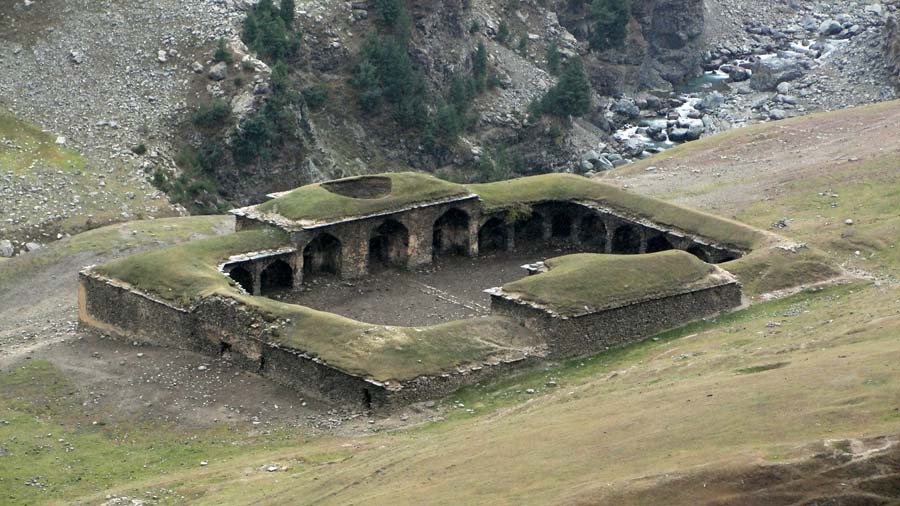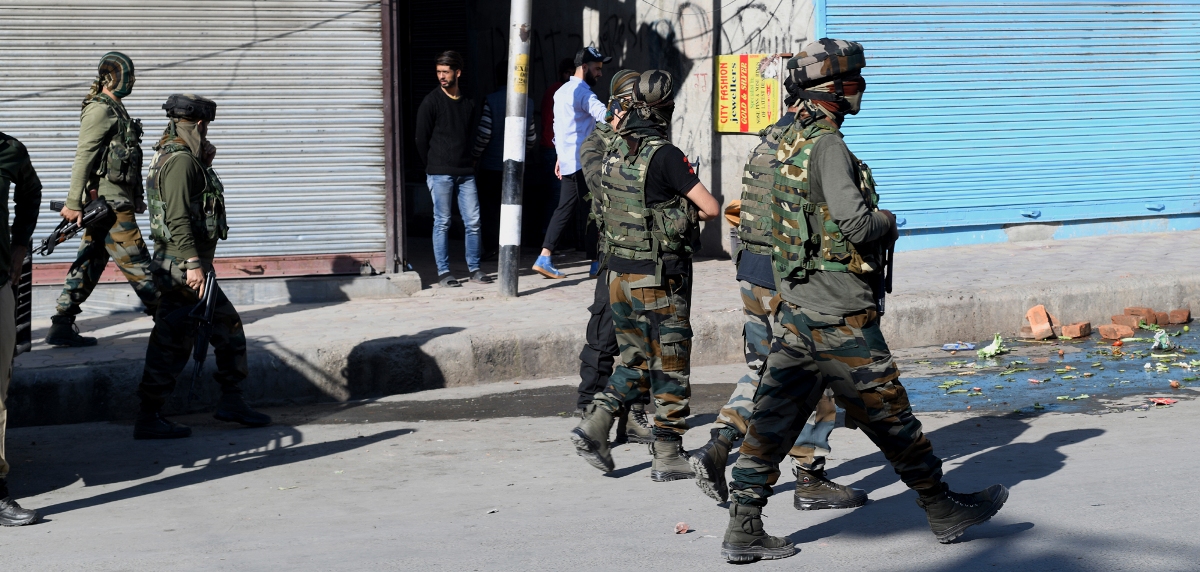Sunaina Malik

The name ‘Peer ki Gali’ indicates: it has some auspicious relevance. As the word ‘peer’ means a person devoted to religion, as per Muslim faith. This holy place Peer ki Gali is situated between two villages, Poshana and Heer Pur, along Mughal road. Peer ki Gali is more likely to be called as heart of Mughal road. The history of this place dates back to the time of a holy and religiously elevated person named as Alamdaar-e-Kashmir, Sheikh Noor-u-Din Noorani (RA) (1378 to 1441).
As per written records, this place got its name because of a converted Hindu saint, Sheikh Ahmed Karim. Barnier Francios, the man who visited this place along with the caravan of Mughal emperor Aurangzeb in 1665, wrote: “The saint was living here from the of Mughal king Jahangir. The saint could perform miracles by producing horrible voices. He could also bring storms along with hail stone and snow. He was an old white bearded man. He ordered the people not to create noise in this calm place of God, move silently, and also demand offerings from them.”
Francois further wrote that the saint happened to met him inside his place of meditation and told him: Mughal king Aurangzeb and Shahjahan were wise enough as they crossed this calm place of God very calmly, unlike Jehangir, who faced doomed outcomes.
The whole population of state still considered Sheikh Ahmed Karim as a saint of high value. Not in ancient times, but even now, he has been called for help whenever people caught in heavy storms. And it is said: he always comes to help the needy.
Saint Karim is also considered as “the living saint”. The story of his being famous as living saint dates back to the time when he used to meditate in these hilly tracks. As per oral legends, he was once meditating before his conversion to Islam. A mother who had lost her son visited him with the help. After hearing her out, he told her: Go forward and search her son. Your son might be coming. The lady searched, but failed. She was again ordered by the saint to resume her search. This time, she indeed traced her son. Alamdaar-e-Kashmir had been watching all this happening. He visited the Hindu saint and invited him to accept Islam, “so that, he may reach heaven”.
Historical records reveal that the saint refused the invitation and instead challenged Alamdaar: Reach heaven by converting to another religion. Alamdaar accepted the challenge and vowed to bring a water melon from heaven by converting to another religion. Both started their journey to heaven. But before entering inside heaven, Alamdaar had to accept Islam as faith.
According to challenge, he succeeded in bringing water melon but before he left the heaven, the branch of water melon was taken by watchman of heaven. When both appeared before each other and after the clearance of facts, it was known that the watchman of heaven was none other than Alamdaar-e-Kashmir. Holy Hindu saint accepted Islam as his faith and was later named as Sheikh Ahmed Karim.
He also requested to Sheikh Noorani to pray for his everlasting life. Sheikh Noorani (RA) prayed to God and as a result Sheikh Ahmed Karim is still being considered as living saint.
The shrine of Peer ki Gali is not Peer’s grave or Mazar, but it is peer’s meditating place. As the mark of his presence, Shrine has the imprints of his hands on a big stone inside it. His grave is situated near the grave of Makhdoom sahib and in the north of grave of Bahuddin Ganj Bakash in Kashmir. Numerous myth related to peer’s miracle are still inhibiting in the subconscious mind of people of state.
The belief that peer being a living saint and spiritually uplifted soul further established by a lady writer who happened to cross this hilly track along with caravan of Sheikh Mohamed Abdullah in 1931-32. “The peer appears on a white horse and says: ‘the road is safe,’ ” she wrote.
In addition to a religious spot, the Peer ki Gali is gaining popularity as beautiful tourist spot. The snow covered peaks surrounding Peer ki Gali are incredible. Single look towards these make you feel lasted in them. These attractive mountainous ranges have mesmerizing effect on reaching here. One can feel him or herself in heaven on earth.
Along with blessing of Sheikh Ahmed, people from the whole state can enjoy the charming scenery here. The refreshing meadow during summer adds the beauty of the place. One can swim in big clouds of mist here while enjoying the matchless bliss of nature.
Above all, availability of horse ride enables you to feel the everlasting scene of Peer ki Gali at its peak. You can also get a chance to traditional tribes of Jammu and Kashmir who live in open huts called Taraas. You can enjoy calm, peaceful, simple and real tribal life here. These tribes have made possible the unending supply of meat and milk for us by carrying this way of life. The spot of Peer Gali is multidimensional in beauty and attraction.
Apart from Peer ki Gali shrine, there are some main historical spots along Mughal road which can entertain the visitors. Ali Abad Sarai is one of Mughal forts constructed by emperor Shahjehan. It is situated in the south of Peer shrine. When the constructor, Ali Mardan Khan, who also constructed the track from Lahore to Kashmir started working on Sarai, he was told by the inhabitants that the place is haunted by a man-eater, Lal Ghulam, who throws everyone to death from this peak and later on eats them. But the constructor, it is said, was strong enough that busted the fear psychosis created by Lal Ghulam. And later on, he completed his work, very calmly.
Poshana is another place located here. Moving to other side of Peer ki Gali in the lap of Peer Panjal, an ancient village Poshana is situated. The village is between 33.38 latitude and 74.32 longitude. Historical relevance of Poshana is proved by its mention in Raj Tarangani, history of Jammu and Kashmir, by Kalhan. Kalhan named Poshana as Poshan Nad, a Sanskrit word meaning: narrow track of air. He further writes that during third century, Poshana witnessed the political rift between Sasals, Baksha Char and Parathvi Har.
There are so many spots relating to Alamdar-e-Kashmir situated here. You can visit the place where he used to offer prayer. It is said that a rock turned into a place for prayers by the orders of Alamdar. This place is known as ‘Stone of Sheikh’. One can also visit a place where he used to take rest. That spot has imprints of his arm. There is a shrine in the village known as Dad Moog. The story of this holy lady moves as there was a spiritual lady who had cows daily. She distributed milk, curd and bread among poor and needy.
Once she was molested by some molesters. In order to save her modesty, she prayed to God. As a result, soil broke into two parts. And she disappeared, but during all this, her shoe and her dupatta remained outside. One can still find it near her shrine.
As per the written records, real track of Mughals for reaching Kashmir was through Poshana. It is because, many utensils which show their link with Mughals have been found by the inhabitants during the construction of their houses prove historical relevance.
Lately, when the state government is giving a facelift to the place, it should also develop link roads towards these historical spots like Poshana. So that, tourists and Kashmiris may have access to visit these places and glimpse the breathtaking beauty of the place.
(The author is a government school teacher posted in Rajouri. She can be reached at [email protected])
















Story is full from spices, Fiction and drama, some contents even are far from reality. Such story must included in child commics.
Your comment…thanks for vailable information